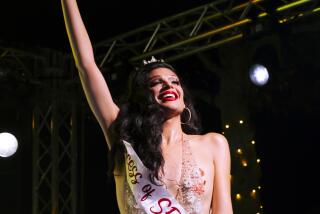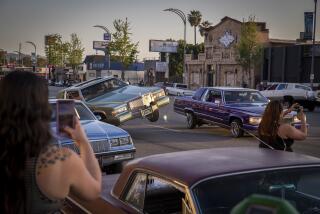Jesse Valadez dies at 64; pioneer of L.A.’s lowriders
An impressively long line of classic lowriders from throughout Southern California and beyond joined the funeral procession that began at St. Alphonsus Catholic Church in East Los Angeles and ended at Rose Hills Memorial Park in Whittier.
On a flatbed truck behind the hearse at the head of the parade Feb. 5 was one of the icons of the lowriding world: “Gypsy Rose,” a fuchsia-colored 1964 Chevy Impala whose body is adorned with hand-painted, multihued roses and whose hot-pink interior includes swivel seats in the front and a cocktail bar and two small light fixtures in the back.
It was a fitting sendoff for the car’s owner: pioneer East Los Angeles lowrider Jesse Valadez, a founding member and a longtime early president of the Imperials Car Club, who died of colon cancer Jan. 29 at his home in East L.A. at age 64.
“That was out of our heart, because the Imperials are still together,” Valadez’s brother, Armando, who co-founded the car club in 1965, said of the funeral procession of hundreds of cars.
“We figured Jesse was president for the longest time,” he told The Times this week, “so we were going to give him the honor, and there were a lot of car clubs there to pay their respects because Jesse was a legend of the lowriders.”
As was Gypsy Rose, whose fame grew beyond lowrider circles in the 1970s, when Valadez was seen driving it in the opening credits of “Chico and the Man,” the popular Freddie Prinze sitcom set in East L.A.
“Jesse was the godfather of lowriding,” said Mike Rivera, a former Imperials Car Club member and former club president. “That’s how respected he was. Even without the Rose, they knew who he was.”
Valadez’s car, which also was seen in the 1979 movie “Boulevard Nights,” was one of the highlights of “La Vida Lowrider: Cruising the City of Angels,” an exhibit that opened in 2007 at the Petersen Automotive Museum in Los Angeles.
In an article on the exhibit, The Times’ car critic Dan Neil wrote “Born of Mexican pride and defiance after World War II, lowriding — a customizing trend in which cars are lowered onto their suspensions, reupholstered and extravagantly painted — has become a quintessentially American tradition.”
And Valadez, Neil wrote, “was among the first to attempt to bring connoisseurship to the hobby with the sumptuous, and expensive, paint scheme on his car.”
“Jesse just took it to a different level,” Rivera said. “There was nobody in the lowrider scene at that time that could even touch him.”
Rivera, who grew up in East L.A. not far from the Valadez family, was 10 when the Imperials Car Club started in 1965. He recalled cleaning, dusting and waxing members’ cars “just to hang around with the club.”
“I told Armando in the church [on Saturday] that back when I was a kid we didn’t have too many superheroes. We had Batman and Robin and Superman and a few others. But I said, ‘You guys’ — Armando, Jesse and another brother, Art — ‘were my superheroes.’ ”
Jesse Valadez, who served as president for 15 years during the 1970s and ‘80s, was voted back in as president of the club late last month.
“He was a mentor to everybody,” said Rivera, who joined the club in 1973. “He always had new ideas about what to do with your car. Not to mention the advice he’d give to everybody. He was wise for his age.”
During their heyday in the 1960s and ‘70s, members of the Imperials Car Club would join other lowrider clubs cruising Whittier Boulevard between Atlantic Boulevard and the 710 Freeway.
But members of the Imperials Car Club weren’t just about cruising and entering car shows, Rivera said.
They performed community service, including painting over graffiti, holding canned food drives for the church where they held their meetings and raising money via small car shows to give to needy families during the holidays.
“That was during Jesse’s reign as president,” Rivera said. “He wanted to give back to the community.”
Rivera said one of the main requirements of the club was that members could not be affiliated with any gang. And the soft-spoken Valadez “always wanted to keep the peace” whenever there was conflict between car clubs, Rivera said.
“We always got along with everybody,” he said. “Jesse made sure of that.”
Born in Nueva Rosita, Coahuila, Mexico, on May 1, 1946, Valadez and his family moved to San Antonio in 1959 and then to East L.A. about two years later.
Valadez owned an auto upholstery shop in Garden Grove for many years.
In addition to his brother Armando, he is survived by his wife, Rosanne; a son, Jesse Jr.; two daughters, Candice and Cindy; and another brother, Gilbert.
Valadez, whose casket was painted fuchsia with multicolored roses to resemble the Gypsy Rose, bequeathed his dream car to his son.
More to Read
Start your day right
Sign up for Essential California for the L.A. Times biggest news, features and recommendations in your inbox six days a week.
You may occasionally receive promotional content from the Los Angeles Times.






